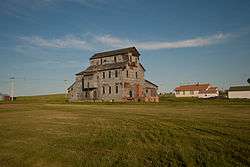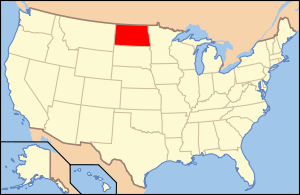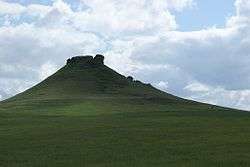Grant County, North Dakota
| Grant County, North Dakota | |
|---|---|
 | |
 Location in the U.S. state of North Dakota | |
 North Dakota's location in the U.S. | |
| Founded | November 28, 1916[1] |
| Named for | Ulysses S. Grant |
| Seat | Carson |
| Largest city | Elgin |
| Area | |
| • Total | 1,666 sq mi (4,315 km2) |
| • Land | 1,659 sq mi (4,297 km2) |
| • Water | 6.8 sq mi (18 km2), 0.4% |
| Population (est.) | |
| • (2016) | 2,377 |
| • Density | 1.4/sq mi (0.5/km2) |
| Congressional district | At-large |
| Time zone | Mountain: UTC−7/−6 |
| Website |
grantcountynd |
Grant County is a county located in the U.S. state of North Dakota. As of the 2010 census, the population was 2,394.[2] Its county seat is Carson.[3] Until November 28, 1916, Grant County was a part of Morton County.[1][4][5] The county was named in honor of General Ulysses S. Grant.
Geography

According to the U.S. Census Bureau, the county has a total area of 1,666 square miles (4,310 km2), of which 1,659 square miles (4,300 km2) is land and 6.8 square miles (18 km2) (0.4%) is water.[6] Lake Tschida, a U.S. Bureau of Reclamation reservoir and recreation area on the Heart River, is the county's largest body of water.[7]
Adjacent counties
- Morton County (northeast)
- Sioux County (south)
- Adams County (southwest)
- Hettinger County (west)
- Stark County (northwest)
Major highways



National protected areas
Demographics
| Historical population | |||
|---|---|---|---|
| Census | Pop. | %± | |
| 1920 | 9,553 | — | |
| 1930 | 10,134 | 6.1% | |
| 1940 | 8,264 | −18.5% | |
| 1950 | 7,114 | −13.9% | |
| 1960 | 6,248 | −12.2% | |
| 1970 | 5,009 | −19.8% | |
| 1980 | 4,274 | −14.7% | |
| 1990 | 3,549 | −17.0% | |
| 2000 | 2,841 | −19.9% | |
| 2010 | 2,394 | −15.7% | |
| Est. 2016 | 2,377 | [8] | −0.7% |
| U.S. Decennial Census[9] 1790-1960[10] 1900-1990[11] 1990-2000[12] 2010-2016[2] | |||
2000 census
As of the census of 2000, there were 2,841 people, 1,195 households, and 800 families residing in the county. The population density was 2 people per square mile (1/km²). There were 1,722 housing units at an average density of 1 per square mile (0/km²). The racial makeup of the county was 96.90% White, 1.72% Native American, 0.35% Asian, 0.35% from other races, and 0.67% from two or more races. 0.60% of the population were Hispanic or Latino of any race. 73.7% were of German, 7.9% Norwegian and 5.2% American ancestry.
There were 1,195 households out of which 25.10% had children under the age of 18 living with them, 60.80% were married couples living together, 3.80% had a female householder with no husband present, and 33.00% were non-families. 31.80% of all households were made up of individuals and 17.90% had someone living alone who was 65 years of age or older. The average household size was 2.30 and the average family size was 2.90.
In the county, the population was spread out with 23.40% under the age of 18, 4.30% from 18 to 24, 20.50% from 25 to 44, 27.10% from 45 to 64, and 24.70% who were 65 years of age or older. The median age was 46 years. For every 100 females there were 104.10 males. For every 100 females age 18 and over, there were 100.30 males.
The median income for a household in the county was $23,165, and the median income for a family was $30,625. Males had a median income of $21,537 versus $17,949 for females. The per capita income for the county was $14,616. About 14.70% of families and 20.30% of the population were below the poverty line, including 24.70% of those under age 18 and 20.90% of those age 65 or over.
2010 census
As of the 2010 United States Census, there were 2,394 people, 1,128 households, and 694 families residing in the county.[13] The population density was 1.4 inhabitants per square mile (0.54/km2). There were 1,690 housing units at an average density of 1.0 per square mile (0.39/km2).[14] The racial makeup of the county was 97.2% white, 1.1% American Indian, 0.1% Asian, 0.2% from other races, and 1.3% from two or more races. Those of Hispanic or Latino origin made up 0.3% of the population.[13] In terms of ancestry, 66.6% were German, 14.0% were Norwegian, 12.5% were Russian, 5.9% were Irish, 5.5% were English, and 2.2% were American.[15]
Of the 1,128 households, 19.6% had children under the age of 18 living with them, 54.7% were married couples living together, 3.9% had a female householder with no husband present, 38.5% were non-families, and 36.5% of all households were made up of individuals. The average household size was 2.10 and the average family size was 2.72. The median age was 51.7 years.[13]
The median income for a household in the county was $39,500 and the median income for a family was $53,542. Males had a median income of $33,750 versus $27,303 for females. The per capita income for the county was $25,840. About 7.3% of families and 13.0% of the population were below the poverty line, including 18.1% of those under age 18 and 18.7% of those age 65 or over.[16]
Communities
Cities
- Carson (county seat)
- Elgin
- Leith
- New Leipzig
Census-designated places
Other unincorporated communities
Townships
Active townships
- Elm
- Fisher
- Freda
- Howe
- Lark
- Leipzig
- Minnie
- Pretty Rock
- Raleigh
- Rock
- Winona
Defunct townships
- Otter Creek[17]
Census-designated places
Politics
| Year | Republican | Democratic | Third parties |
|---|---|---|---|
| 2016 | 80.2% 1,108 | 13.4% 185 | 6.4% 88 |
| 2012 | 72.5% 1,025 | 23.6% 334 | 3.8% 54 |
| 2008 | 64.9% 873 | 30.1% 405 | 5.0% 67 |
| 2004 | 76.7% 952 | 21.3% 264 | 2.1% 26 |
| 2000 | 75.5% 1,077 | 16.5% 235 | 8.1% 115 |
| 1996 | 55.5% 760 | 21.9% 300 | 22.6% 309 |
| 1992 | 45.9% 900 | 21.2% 415 | 32.9% 644 |
| 1988 | 66.1% 1,351 | 32.0% 654 | 1.9% 38 |
| 1984 | 74.9% 1,607 | 23.6% 507 | 1.5% 31 |
| 1980 | 80.9% 1,891 | 13.6% 317 | 5.6% 131 |
| 1976 | 53.4% 1,205 | 42.2% 952 | 4.5% 101 |
| 1972 | 70.2% 1,569 | 26.7% 596 | 3.2% 71 |
| 1968 | 71.8% 1,648 | 21.3% 488 | 7.0% 160 |
| 1964 | 57.1% 1,421 | 42.7% 1,063 | 0.2% 4 |
| 1960 | 65.2% 1,794 | 34.7% 955 | 0.1% 2 |
| 1956 | 72.0% 1,872 | 27.6% 718 | 0.4% 9 |
| 1952 | 85.3% 2,465 | 14.0% 403 | 0.7% 21 |
| 1948 | 66.9% 1,555 | 29.7% 689 | 3.4% 79 |
| 1944 | 80.6% 1,745 | 19.0% 410 | 0.4% 9 |
| 1940 | 81.5% 2,815 | 18.2% 627 | 0.3% 11 |
| 1936 | 29.6% 1,022 | 53.8% 1,858 | 16.7% 576 |
| 1932 | 18.0% 657 | 79.7% 2,912 | 2.3% 85 |
| 1928 | 54.6% 1,759 | 44.5% 1,434 | 0.9% 29 |
| 1924 | 39.1% 1,120 | 4.4% 125 | 56.6% 1,622 |
| 1920 | 83.2% 2,184 | 11.3% 296 | 5.6% 146 |
See also
References
- 1 2 Long, John H. (2006). "Dakota Territory, South Dakota, and North Dakota: Individual County Chronologies". Dakota Territory Atlas of Historical County Boundaries. The Newberry Library. Archived from the original on 2007-11-11. Retrieved 2008-01-31.
- 1 2 "State & County QuickFacts". United States Census Bureau. Archived from the original on July 10, 2011. Retrieved October 31, 2013.
- ↑ "Find a County". National Association of Counties. Archived from the original on 2011-05-31. Retrieved 2011-06-07.
- ↑ Certification of the division of Morton County, ND 28 November 1916 Archived 3 July 2008 at the Wayback Machine.
- ↑ "County History". North Dakota.gov. The State of North Dakota. Retrieved February 1, 2015.
- ↑ "2010 Census Gazetteer Files". United States Census Bureau. August 22, 2012. Archived from the original on January 29, 2015. Retrieved January 28, 2015.
- ↑ "Heart Butte Reservoir". Recreation.gov. U.S. Bureau of Reclamation. Retrieved 2010-06-03.
- ↑ "Population and Housing Unit Estimates". Retrieved June 9, 2017.
- ↑ "U.S. Decennial Census". United States Census Bureau. Archived from the original on May 12, 2015. Retrieved January 28, 2015.
- ↑ "Historical Census Browser". University of Virginia Library. Retrieved January 28, 2015.
- ↑ Forstall, Richard L., ed. (March 27, 1995). "Population of Counties by Decennial Census: 1900 to 1990". United States Census Bureau. Retrieved January 28, 2015.
- ↑ "Census 2000 PHC-T-4. Ranking Tables for Counties: 1990 and 2000" (PDF). United States Census Bureau. April 2, 2001. Retrieved January 28, 2015.
- 1 2 3 "DP-1 Profile of General Population and Housing Characteristics: 2010 Demographic Profile Data". United States Census Bureau. Retrieved 2016-03-14.
- ↑ "Population, Housing Units, Area, and Density: 2010 - County". United States Census Bureau. Retrieved 2016-03-14.
- ↑ "DP02 SELECTED SOCIAL CHARACTERISTICS IN THE UNITED STATES – 2006-2010 American Community Survey 5-Year Estimates". United States Census Bureau. Retrieved 2016-03-14.
- ↑ "DP03 SELECTED ECONOMIC CHARACTERISTICS – 2006-2010 American Community Survey 5-Year Estimates". United States Census Bureau. Retrieved 2016-03-14.
- ↑ "Geographic Change Notes for North Dakota". United States Census Bureau. Archived from the original (TXT) on 2012-10-10. Retrieved 2010-06-17.
- ↑ Leip, David. "Dave Leip's Atlas of U.S. Presidential Elections". uselectionatlas.org. Retrieved 2018-04-12.
Further reading
Kane, Joseph Nathan; Charles Curry Aiken (2004). The American Counties: Origins of County Names, Dates of Creation, and Population Data, 1950-2000 page 116. Scarecrow Press. p. 552. ISBN 0-8108-5036-2.
